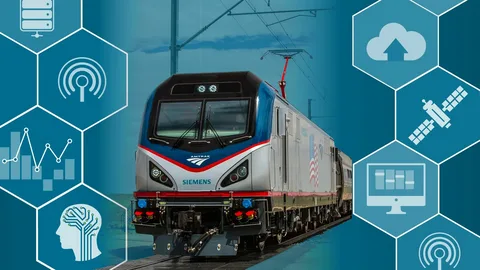
The railway telematics industry was valued at around USD 6,234.5 million in 2022. According to a recent market analysis report by FMI, the market is set to grow at a CAGR of 7.1% between 2023 and 2033. This growth trajectory is projected to elevate the market’s overall value from USD 6,708.3 million in 2023 to an estimated USD 13,320.1 million by 2033.
The global railway telematics market is anticipated to grow substantially over the coming decade, fueled by the rising adoption of advanced digital solutions aimed at enhancing safety, operational efficiency, and asset management within the rail industry. Railway telematics systems provide real-time tracking, diagnostics, and data analytics, enabling rail operators to optimize fleet performance, manage maintenance schedules, and improve overall safety. As rail networks across the world prioritize modernization and digitization, railway telematics is emerging as an essential tool to support the industry’s transformation.
Key drivers of this growth include increased government investments in smart transportation, heightened safety regulations, and the need to minimize operational downtime. Railway telematics solutions are particularly valuable for freight operations, where they help track cargo, monitor conditions, and reduce transportation delays. As the demand for more reliable and efficient rail operations continues to rise, telematics technology is set to play a critical role in advancing the industry toward a more digital, connected future.
In-Depth Market Analysis: A Complete Report
Key Market Drivers:
- Demand for Real-Time Tracking: Telematics systems allow operators to track trains, cargo, and assets in real time, improving logistics and enhancing customer satisfaction.
- Focus on Safety and Compliance: With stricter regulatory standards, railway telematics solutions help ensure adherence to safety protocols, minimizing the risk of accidents and disruptions.
- Increasing Efficiency and Cost Savings: By enabling predictive maintenance and monitoring asset health, telematics reduces downtime and optimizes maintenance costs.
- Technological Advancements: Ongoing innovations in IoT and data analytics are making telematics solutions more accessible and efficient for the rail sector.
Key Takeaways
- Enhanced Fleet Management: Railway telematics allows operators to monitor fleet conditions and performance in real-time, leading to better resource allocation and optimized operational efficiency.
- Improved Safety Protocols: Telematics systems provide critical data that enhances safety measures, ensuring that railways comply with regulatory standards and operate safely.
- Cost Optimization Through Predictive Maintenance: By analyzing telematics data, operators can conduct predictive maintenance, minimizing unplanned downtime and reducing maintenance costs.
- Higher Demand for Freight Telematics: Freight rail operators benefit from telematics through improved cargo tracking and delivery accuracy, addressing the growing need for reliable logistics solutions.
- Support for Sustainability Initiatives: Railway telematics contributes to sustainability goals by promoting fuel efficiency and reducing unnecessary trips, aligning with the broader objectives of environmental responsibility.
Key Players Profiled in the Railway Telematics Industry Report
- Siemens AG
- Alstom SA
- Knorr-Bremse AG
- Robert Bosch GmbH
- Hitachi Ltd.
- Intermodal Telematics
- Intrex Telematics
- ORBCOMM
- Railnova
- Savvy Telematics
- Trinity Industries
Key Segmentations
By Solution:
- Fleet Management
- Automatic Stock Control
- Shock Detection
- Remote data access
- Railcar tracking and tracing
- Reefer Wagon Management
- ETA
- others
By Railcar:
- Hoppers
- Tank cars
- Well cars
- Boxcars
- Refrigerated Boxcars
- Others
By Components:
- TCU
- Sensor
- Others
By Train Type:
- Passenger Train
- Freight Train
- Others
By Region:
- North America
- Latin America
- Europe
- East Asia
- South Asia and the Pacific
- Middle East and Africa (MEA)
